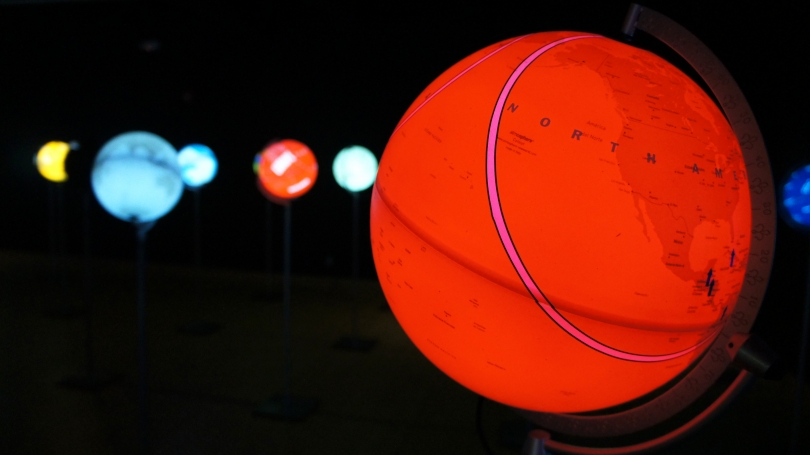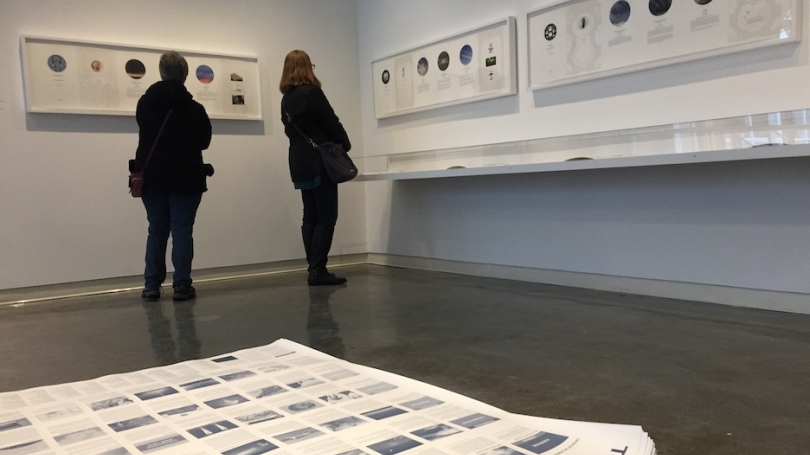Hood Quarterly, spring 2017
Juliette Bianco, Deputy Director
Katherine Hart, Senior Curator of Collections and Barbara C. and Harvey P. Hood 1918 Curator of Academic Programming
Ingo Günther: World Processor
Hood Downtown | March 24–May 28, 2017
Amy Balkin and Luis Delgado-Qualtrough
Strauss Gallery, Hopkins Center for the Arts | March 24–April 30, 2017
This spring, the Hood dips into the world of big data by presenting two exhibitions that highlight three artists’ use of information—a commodity in generous supply in the age of the Internet. Each of the three artists, Ingo Günther, Luis Delgado-Qualtrough, and Amy Balkin, challenge our thinking about world issues—including the environment, history, human systems, and politics—from a global perspective.
Ingo Günther, whose work is featured in Hood Downtown, has been making a series titled World Processor for over twenty-five years. His installation in Hanover of over fifty illuminated globes draws attention to what is knowable about the world from the perspective of data and statistics. Drawing on the United Nations’ Human Development Reports, as well as other statistics gathered from institutions, agencies, and independent researchers, Günther selects subjects that, when graphically visualized, alter our perceptions of the world. Each globe tackles an issue, such as life expectancy, immigration centers, locations of fiber optic cable, concentrations of billionaires, or shrinking of rain forests in various parts of the world at the point the given globe was made (Günther occasionally updates globes when the data have significantly changed). Most of his topics are easily comprehended visually but challenging to absorb through prose, numbers, charts, or graphs. For example, his globes present locations where walls exist along national borders or dead zones in large lakes or oceans caused by pollution from human activity and other factors.
Günther began his career as a video artist and then became a journalist, and he combines these interests in World Processor, which has been shown in twenty countries and is on permanent display in three: Japan, Switzerland, and Germany. Günther chose the globe as a medium in 1989 partly because the form is familiar to most people. By replacing geography with what he calls “human reality,” he confronts the viewer with unexpected data, such as, for example, the relationship between average personal income and labor migration patterns worldwide. Amid this sea of facts, Günther warns, “information or even visualizing information in the shape of a sphere . . . may give you a sense of control and understanding that you don’t actually have.” The artist hopes that these globes provide viewers with alternative ways of connecting with stories from the daily news cycle, and, in an era when news is being increasingly shaped by its consumers, this can only be a good thing.
On view in the Strauss Gallery, Hopkins Center, Luis Delgado-Qualtrough’s 10 Carbon Conundrums series, published both in portfolio format and as single prints, engages with its subjects across time. Constructed as a conversation between two fictional characters, Lisdebertus and Cedric Tlapatotoli, these prints, the artist says, “riff on issues and views regarding the changing circumstances of earth and human impact on the environment. The images and text are linked through a common date, connecting common paths of experience and denunciation.” Each conundrum is titled and addresses such themes as “Manifest Destiny,” “Horseless,” “King Coal,” “Better Living through Chemistry,” and “Big Data.” The juxtapositions within each of these categories create what one reviewer described as “easily some of the most delicately subversive work” in a recent biennial of photography at the international FotoFest in Houston.
Amy Balkin is a San Francisco–based conceptual artist who activates images of and data about the physical and human landscape to address the issue of human-influenced climate change and its reciprocal effect on lived experience. Balkin presented her ongoing work titled Public Smog at the Kassel-based exhibition dOCUMENTA (13) in 2012 as an argument for adding the earth’s atmosphere to the UNESCO world heritage list. Her work in the current exhibition in Strauss Gallery, The Atmosphere: A Guide (2013/16), is a poster essay documenting the human fingerprint on the sky, from the tangible form of chemical traces and space junk to events such as Joseph Kittinger’s 1959 jump in a pressurized suit from an altitude of 19.5 miles above the earth’s surface. Visitors are invited to take a copy of The Atmosphere: A Guide from the stack of 32 x 48-inch sheets of paper in the gallery and display it at home.
We presented these companion exhibitions, under the umbrella title of Mining Big Data, to explore how museums like the Hood Museum of Art can encourage multivalent dialogue about topics of both local and global importance. These three artists’ interventions with big data allow us to both visualize world-impacting histories, trends, and events and experience art and information as social provocation. Like a work of art, big data does not present answers but rather fodder for myriad questions, some of which are unanswerable. Through their merging of art and data, Amy Balkin, Luis Delgado-Qualtrough, and Ingo Günther test our conceptions of the known world and the limits of our imaginations.



